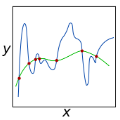Physics-informed neural networks (PINNs) are a promising approach that combines the power of neural networks with the interpretability of physical modeling. PINNs have shown good practical performance in solving partial differential equations (PDEs) and in hybrid modeling scenarios, where physical models enhance data-driven approaches. However, it is essential to establish their theoretical properties in order to fully understand their capabilities and limitations. In this study, we highlight that classical training of PINNs can suffer from systematic overfitting. This problem can be addressed by adding a ridge regularization to the empirical risk, which ensures that the resulting estimator is risk-consistent for both linear and nonlinear PDE systems. However, the strong convergence of PINNs to a solution satisfying the physical constraints requires a more involved analysis using tools from functional analysis and calculus of variations. In particular, for linear PDE systems, an implementable Sobolev-type regularization allows to reconstruct a solution that not only achieves statistical accuracy but also maintains consistency with the underlying physics.
翻译:物理学启发的神经网络(PINNs)是一种有前途的方法,它将神经网络的强大能力与物理建模的可解释性结合起来。PINNs已经在求解偏微分方程(PDEs)和混合建模方案方面表现出良好的实际性能,其中物理模型增强了数据驱动方法。然而,为了全面了解它们的能力和局限性,建立它们的理论属性是至关重要的。在本研究中,我们强调了经典PINNs训练可能遭受系统过拟合的问题。可以通过向经验风险添加岭正则化来解决这个问题,这可以确保得到的估计器对于线性和非线性PDE系统都是风险一致的。然而,将PINNs强大地收敛到满足物理约束的解需要更多的分析工具,例如函数分析和变分法。特别是,对于线性PDE系统,可实现的Sobolev型正则化可使重新构建的解不仅实现统计精度,而且还保持与潜在物理学的一致性。

